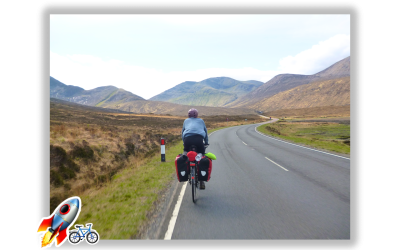Definition of the Last Mile
We’re not talking about running. Nor a disaster movie. The “last mile” simply refers to the final or initial segment of an individual journey made by public transport. Concretely, when you arrive at your final destination by train, bus, or plane (this is the last time, we’re watching you) and you need to get to your accommodation or the heart of your destination, the portion you still have to cover locally is what’s called the “last mile”.
On a daily basis, poor transport connections to a train station can be a problem. Getting to work by train, regional train (TER), or bus often requires completing the last mile on foot or by renting a shared bike.
Yes, it complicates the journey, but it’s still doable. However, things get trickier when you’re on vacation.
The luggage to carry, unfamiliarity with the area, and the urgent desire to relax make completing the last mile more complicated. What starts as a comfort issue becomes a real logistical challenge, which can turn into a barrier to using public transport for travel.

Does it really live up to its name?
The concept of the “last mile” is defined as the final stage of a journey—the part that makes public transport trips much more complex than traveling by private car. However, this designation of “last” mile is being questioned.
Ultimately, when we arrive at the station of our destination, isn’t that the beginning of our journey? Rather than being the last mile of our trip to the destination, isn’t it actually the first mile of our on-site adventure?
That’s why we challenge the notion of the last mile. For us, it is actually the first mile truly traveled by the user after taking public transport (train, plane, bus, etc.) to reach their destination.
But whatever it’s called, the issue remains the same. Poor management of this last mile, due to a lack of satisfactory options to complete it, is a problem that needs addressing.

Why is it a problem?
“For a 100-kilometer journey to work smoothly, it’s not enough for the first 99 kilometers to be flawless—especially if the last mile is a frustrating waste of time.”*
The concern? That users will choose private cars for their journeys instead of opting for public transport.
We won’t praise the merits of the car, but it does allow relatively easy access to one’s accommodation. This is where soft mobility needs to be adapted. Whether it’s a train, bus, or regional train (TER), this mode of transport rarely brings us right to the door of our campsite or lodging. We can speak of a real gap, a “tourism void” (similar to a legal void) when it comes to serving this part of a journey made using soft mobility.
To address this gap, solutions are needed. The goal? To make public spaces accessible to travelers, seen as temporary residents with different needs, in order to promote the use of soft mobility, even on vacation.

How to make it easier?
Between innovative solutions and creative repurposing of traditional transport modes, many approaches can be imagined to ease this last (or first) mile. But faced with numerous failures from supposed innovations, traditional transport modes have had to adapt.
Unsatisfactory Innovative Solutions
A shuttle… is that really innovative? Yes. Even more so if it’s autonomous. This is exactly what the Val-Thorens ski resort offered in 2019. An electric autonomous shuttle that could transport 300 skiers in 30 days. This mode of transport already existed in major cities, but Val-Thorens was the first to test this technology in a winter sports resort. Thanks to the ANMSM (National Association of Mountain Resort Mayors) and the Sustainable Peaks Commission, this solution was trialed in the mountains.
It seems 2019 was the year of autonomous shuttle experiments, as Lacanau, in southwestern France, also implemented an autonomous electric coastal shuttle. The best part? The shuttle was completely free for both residents and tourists.
But five years later, when researching these promising transport modes, we hit a wall. Or rather, a void.
In 2019, these experiments were the subject of several flattering articles—but since then, no news. Good news? No. Because these initiatives stopped at the experimental stage. Touted as the next transport revolution, autonomous shuttles are now better known for the many failures they have faced than for their successes.
Well, if autonomous shuttles won’t ease the last mile, let’s instead look to the skies.
We’ve seen numerous startups dive into developing “flying taxi” prototypes—pilotless, electric aircraft with vertical takeoff and landing capabilities. The online travel agency kiwi.com had set its sights on tackling the last mile problem through this new mode of transport. By investing in the Czech startup Zari, the goal was to offer a drone capable of carrying up to four passengers. The French startup EVA (Electric Visionary Aircrafts) pursued the same goal. These futuristic taxis promised to solve last mile issues.
But what about these innovations in 2024? Well, not much. No matter how much we look up, we still don’t see flying taxis.
And yet, the topic is at the heart of all discussions related to the 2024 Olympic Games to be held in Paris this summer. The trial of electric flying taxis during this period and until the end of 2024 has been approved by the Ministry of Transport. Approved, yes, but not entirely. These flying taxis will be limited to demonstration flights during the Games. Meanwhile, the Paris city hall is pushing back… They call it an “ecological aberration for the ultra-rich” and remain firmly opposed to the project. They have even initiated proceedings to urgently suspend the decree authorizing the trial. So we won’t be counting on this promise of fast and affordable transport for travelers—not for summer 2024, at least.
So much for shuttles, whether autonomous or flying, as innovative solutions to solve the so-called last mile.
Repurposing Traditional Modes of Transport

In response to these failures, the focus shifted toward repurposing traditional modes of transport to better serve the last mile.
First, we think of what are called the new mobility players, even if they’re not so new anymore: ride-hailing services like Uber. This is the case in the city of Nice, which has partnered its public transport network with the American giant. The goal? To offer a complementary night-time transport service to help users cover their last miles.
Accommodations are also tackling the problem head-on. In Strasbourg, for example, the Obernai campground offers public transport connecting the site to the city center and train station. Similarly, in Les Sables d’Olonne, the Puits Rochais campground is served by a bus linking it to the station.
These solutions are commendable, but we do have our favorite. For Loopi, no suspense: the best solution for the last mile is using a private bike.
While this solution remains one of the least polluting, it is also among the most challenging. Riding a bike to explore areas is easy, but transporting your bike on public transport is much less so.
Fortunately, more and more transport providers and destinations are addressing the issue by offering solutions and infrastructure to make bike travel easier. Notably, we’re seeing the rise of dedicated bike parking facilities near train stations. For example, at Gare du Nord in Paris, the largest bike parking facility in France was established some time ago. With over 1,000 spaces, it serves users who want to take public transport via a dedicated bike lane and direct access to the station. And if you prefer to take your bike on the train, we recommend checking out the guide published by Les Others on traveling by train with a bike.
Once at your destination, challenges can arise as well. Not all accommodations are necessarily equipped with bike-friendly facilities. But here too, progress is being made, with dedicated infrastructure emerging. For example, Cyclocamp, led by Célian Cayzac, aims to offer multi-service reception spaces for cycle tourists in various regions. Their first module was launched this summer at Camping Le Soleil in La Rochelle to welcome bike travelers.
Let’s quickly get back to digital solutions helping users with the last mile. For now, there’s only one that truly delivers (see what we did there?): MaaS.
Empowering travelers to optimize their own journeys, MaaS supports users throughout their trip, including that tricky last segment. That’s why we’re developing Tourism MaaS, so that this support continues even on vacation.
*https://www.quotidiendutourisme.com/actualite/e-tourisme/les-enjeux-du-dernier-kilometre-dans-la-mobilite-touristique-557218.php ; Quotidien du Tourisme; “The Challenges of the Last Mile in Tourist Mobility”



